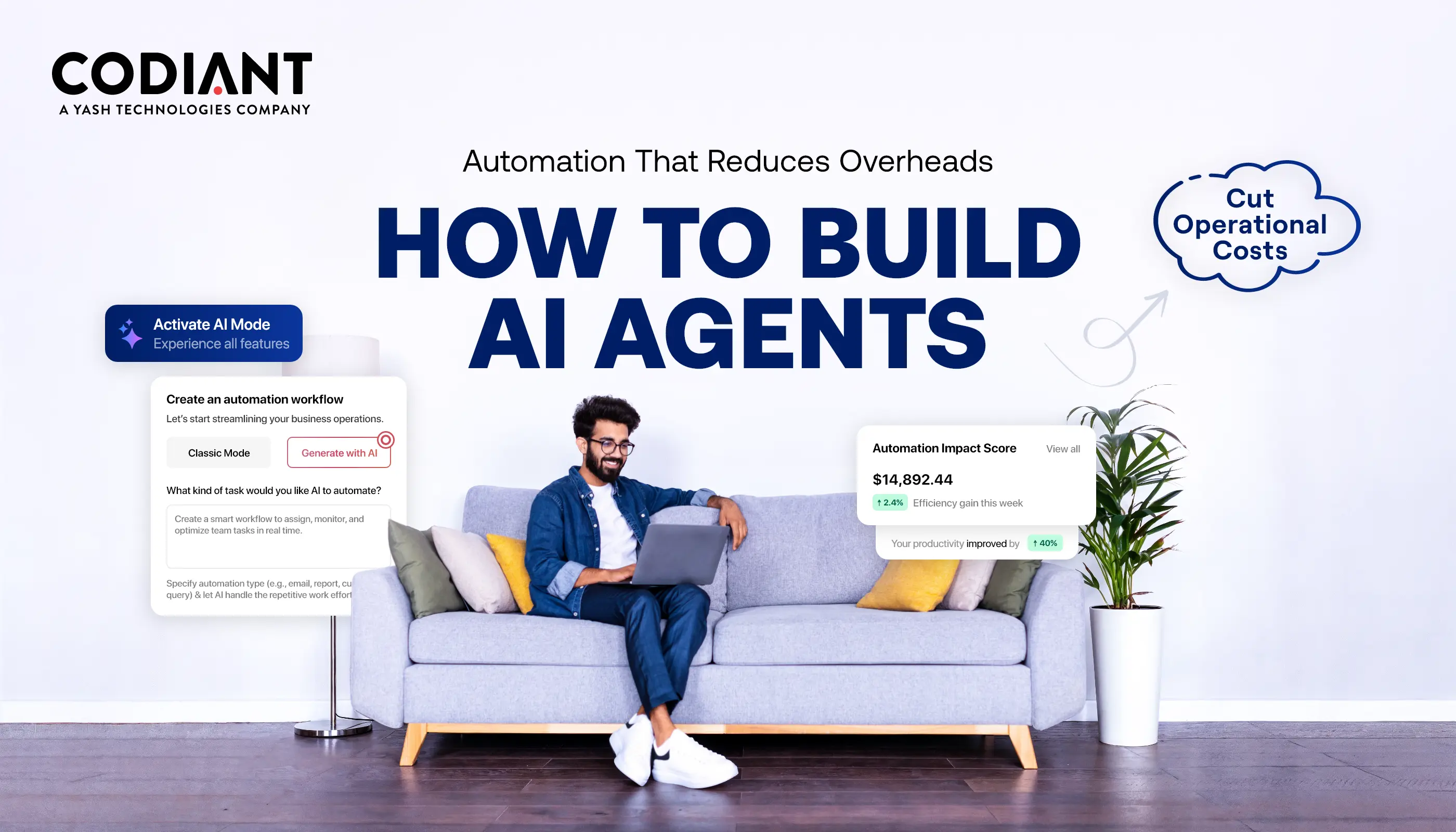How to Digitize Your Home-Service Business with an AI-Powered Platform
Table of Contents
Subscribe To Our Newsletter
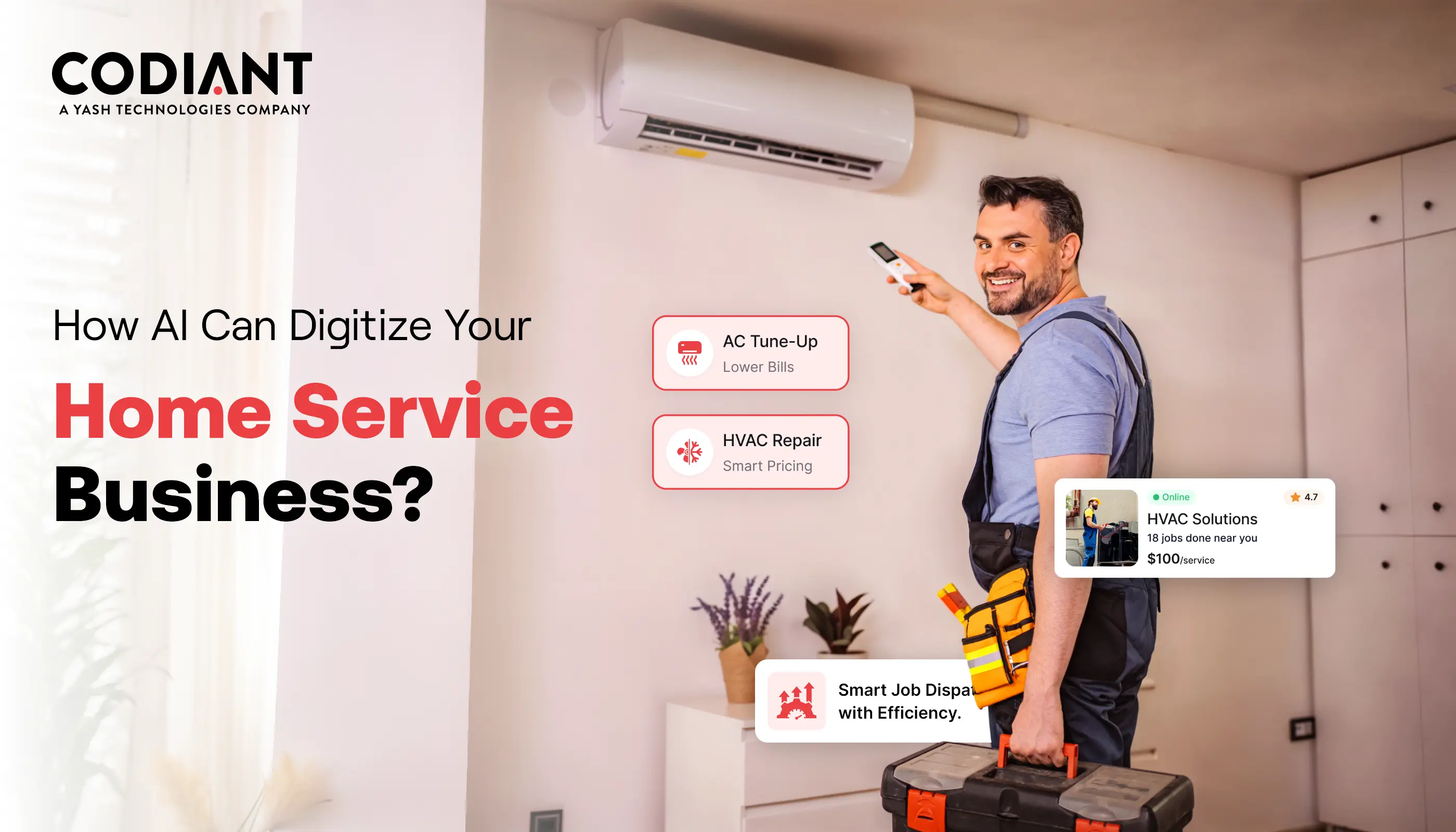
The home-service industry – covering HVAC, plumbing, electrical, and cleaning—has long relied on manual scheduling, phone-based bookings, and paper invoices. But as customer expectations shift toward instant communication and transparency, these traditional processes are no longer enough. Businesses that want to stay competitive are now turning to digital tools that automate operations and improve service delivery.
An AI-powered home-service platform helps companies digitize their home-service business by unifying all key functions – scheduling, dispatch, billing, customer communication, and technician tracking – into one intelligent system. Through home-service business automation, AI can predict peak service times, assign the right technicians, optimize routes, and send real-time updates to customers, reducing delays and manual effort.
This guide explains how to digitize your operations using AI, from choosing the right technology to achieving measurable results like faster bookings, lower costs, and higher customer satisfaction.
You’ll also learn about the key features of digital home-service software, the difference between white-label and custom platforms, and how automation directly boosts ROI. Whether you’re running a small plumbing company or a large HVAC service brand, adopting an AI-driven approach can transform your workflow, enhance efficiency, and future-proof your business for the digital age.
Step-by-Step: How to Digitize Your Home-Service Business with AI
Digitizing a home-service business might sound complex, but it’s a structured, achievable process when approached step by step. Whether you run an HVAC, plumbing, electrical, or cleaning company, the key lies in identifying what slows you down and automating it with the right AI-powered home-service platform.
Below is a practical roadmap to help you modernize your operations, improve customer experiences, and grow faster with digital tools.
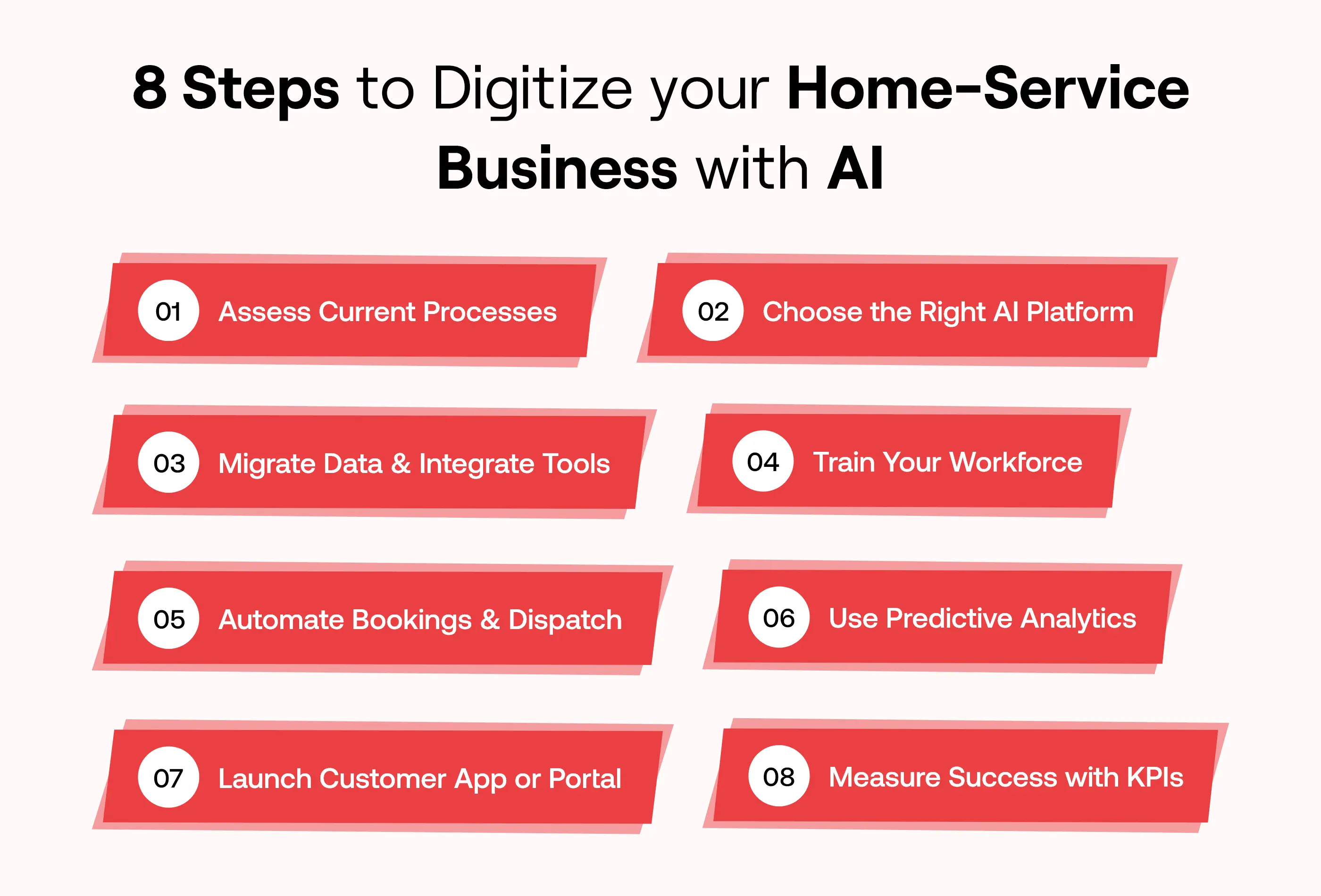
Step 1: Assess Current Processes (Identify Manual, Time-Consuming Tasks)
The first step in your digital transformation is understanding how your business currently works. Map out every process — from receiving a booking to dispatching technicians, tracking jobs, and invoicing customers.
Most home-service providers still rely on manual methods: phone-based scheduling, paper records, and offline payments. These not only eat up time but also cause human errors and delays.
Ask yourself:
- How much time does it take to schedule a single job?
- Are technicians updating job status in real time?
- How do you track customer feedback or service quality?
Documenting these gaps helps identify what can be automated through AI-based service management software. For example, if customer follow-ups take hours, an AI chatbot can automate reminders and confirmations. If technician routes are inefficient, AI can optimize them for reduced travel time.
By the end of this step, you should have a clear list of bottlenecks — your baseline for measuring digital progress later.
Step 2: Choose the Right AI Platform (Checklist of Must-Have Features)
Once you know where inefficiencies exist, it’s time to find the right AI-powered home-service platform that fits your needs.
Here’s a quick checklist of must-have features:
- AI-driven scheduling and dispatch: Automatically assign technicians based on availability, skills, and proximity.
- Smart booking assistant: AI chatbot or voice assistant to handle customer queries and bookings 24/7.
- Real-time technician tracking: GPS and route optimization for better visibility and faster response.
- Integrated payments and invoicing: Enable customers to pay securely online and generate digital receipts.
- Analytics dashboard: View job performance, customer satisfaction, and financial summaries in one place.
- White-label customization: If you plan to rebrand or expand, ensure your platform supports custom branding.
Opt for a mobile-first platform for service businesses so your staff and technicians can manage tasks on the go. Before you commit, ask vendors about scalability, data security, support, and training options. The goal is to choose a tool that grows with your business and adapts to future technologies.
Step 3: Migrate Data & Integrate Tools (CRM, ERP, GPS, Payment Gateways)
Once your platform is selected, the next phase involves connecting your existing systems and data.
Start by importing:
- Customer records from spreadsheets or CRMs.
- Job histories from manual logs.
- Technician details including schedules and availability.
- Inventory and billing data for invoicing and tracking materials.
Most modern AI-powered home-service software supports integration with CRMs (like HubSpot or Zoho), GPS trackers, and payment gateways such as Stripe, PayPal, or Razorpay.
These integrations eliminate data silos and give you a unified view of your operations.
For example, when a customer books a plumbing repair, the system automatically triggers job creation in the CRM, schedules a nearby technician via GPS, and sends an invoice link post-completion.
The entire cycle becomes seamless — no manual handoffs, no missed updates.
Step 4: Train Your Workforce (AI Literacy and Process Adoption)
Digital transformation isn’t just about technology; it’s about people. Your team must be comfortable using AI tools for the transition to succeed.
Conduct short training sessions or workshops to explain:
- How the new platform automates scheduling, dispatching, and billing.
- How AI recommendations (like predictive maintenance alerts) should be acted upon.
- How technicians can use the mobile app for check-ins, job tracking, and digital invoicing.
Encourage adoption by showing real examples — how the AI chatbot handles customer requests faster or how automated routing saves drive time.
Remember: AI isn’t replacing staff; it’s amplifying their productivity. When employees understand the benefits, they’re more likely to embrace digital workflows.
Step 5: Automate Bookings, Dispatch, and Notifications (Workflow Examples)
This step marks the real start of automation. Once data and teams are ready, use your AI-powered home-service platform to handle end-to-end service management.
Here’s how a typical automated workflow looks:
- A customer books a service through your website or app.
- The AI chatbot confirms availability and schedules the job instantly.
- The system checks technician schedules and automatically assigns the best match based on proximity and skill.
- Both customer and technician receive real-time notifications.
- GPS tracking shows the technician’s live route and ETA.
- Once the job is done, the system auto-generates the invoice and requests a customer rating.
This automation eliminates manual scheduling calls, reduces errors, and speeds up operations. For HVAC and plumbing businesses handling multiple daily calls, automation can cut coordination time by up to 60%.
Over time, the AI learns patterns — busiest days, high-demand zones, recurring issues — and adjusts schedules or inventory proactively.
Step 6: Use Predictive Analytics for Growth Decisions
After automation is in place, use predictive analytics to make smarter business decisions. AI tools analyze your service data to uncover trends, forecast demand, and prevent issues before they occur.
For example:
- Predictive maintenance: AI can track service histories and suggest when a customer’s AC might fail next.
- Demand forecasting: It predicts seasonal spikes, helping you allocate technicians efficiently.
- Customer insights: AI identifies which services or locations generate the most revenue.
By analyzing this data, you can plan marketing campaigns better, reduce downtime, and personalize offers.
For instance, if your analytics show that plumbing emergencies increase during winter, you can pre-assign technicians and run preventive maintenance campaigns in advance.
AI doesn’t just automate your present — it prepares your business for future growth.
Step 7: Launch Customer Mobile App or Portal
A modern AI-powered home-service business isn’t complete without a customer-facing mobile app or portal. This is where digital convenience truly shines.
Your app should allow customers to:
- Book services instantly via chat or form.
- View technician profiles and live tracking.
- Get instant pricing, estimates, and e-receipts.
- Make secure payments and apply discounts.
- Leave feedback after job completion.
AI enhances this experience with personalized recommendations, voice-based interactions, and predictive suggestions (e.g., reminding users to book their next AC maintenance).
For example, a white-label platform can be branded under your company name, giving customers a seamless digital experience without building a new app from scratch. This mobile-first approach not only simplifies service requests but also builds customer loyalty through transparency and accessibility.
Step 8: Measure Success with KPIs (Response Time, NPS, Cost Savings, Job Completion Rates)
Digitization is only successful when it’s measurable. Once your AI platform is live, track key performance indicators (KPIs) to assess impact and ROI.
Here are essential metrics to monitor:
- Response Time: Time taken from booking to technician dispatch.
- Customer Satisfaction (NPS): Track feedback and ratings to evaluate experience.
- Job Completion Rate: Measure how many jobs are finished on schedule.
- Cost Savings: Compare pre- and post-automation operational costs.
- Repeat Bookings: A rise indicates improved customer trust and retention.
AI dashboards can display these metrics in real time, helping managers spot trends and refine processes.
Example: After implementing automation, HVAC companies often see a 30–40% reduction in scheduling delays and a 25% increase in customer retention.
Regularly reviewing these KPIs ensures your business stays efficient and scalable while maximizing ROI.
How Long Does It Take to Digitize a Home-Service Business Using AI Tools?
The timeline depends on the complexity of your operations and the readiness of your data. For small service providers, a basic AI-powered home-service app can be deployed within 4 to 6 weeks using a white-label model.
Larger enterprises integrating CRMs, ERP systems, and multi-location tracking may need 3 to 6 months for full rollout and staff training.
It’s best to start small — automate one process (like bookings) first, then expand to dispatch, invoicing, and analytics. Incremental transformation is faster, cost-effective, and less disruptive.
Can Small Home-Service Providers Afford AI-Powered Platforms?
Absolutely. The misconception that AI tools are expensive is fading quickly. Today, white-label home-service software and SaaS-based AI platforms allow small and local providers to digitize operations at minimal upfront cost.
Instead of developing from scratch, small businesses can subscribe to monthly plans starting as low as a few hundred dollars, depending on the number of users and modules.
The key advantages:
- No heavy infrastructure investment.
- Scalable pay-as-you-grow pricing.
- Continuous updates and AI improvements from the vendor.
So yes, even a two-person HVAC or plumbing team can use AI to manage bookings, dispatch jobs, and build customer trust through automation – without breaking the bank.
Ready to Bring AI into Your Workflow?
Let our experts help you map automation opportunities and design a tailored digital strategy for growth.
Key Features to Look for in an AI-Powered Home-Service Platform
When you decide to digitize your home-service business, choosing the right platform is crucial. A strong AI-powered home-service platform should not only simplify operations but also enhance customer experience and maximize your team’s productivity. Here are the core features that make a real difference:

1. Automated Scheduling and Route Optimization
AI-driven scheduling automatically assigns the best technician for each job based on skill, location, and availability. Route optimization tools reduce travel time and fuel costs by suggesting the most efficient paths. This ensures timely service delivery and improved customer satisfaction while cutting operational costs.
2. AI Chatbots & Voice Assistants
An intelligent chatbot or voice assistant can handle bookings, answer FAQs, and update customers about technician arrival times. These tools ensure 24/7 customer interaction without needing human intervention, helping you capture more leads and deliver instant support across web and mobile apps.
3. Integrated Payment Systems
Seamless payment integration lets customers pay instantly through multiple options—credit cards, wallets, or online banking. The system can also generate automated invoices, send payment reminders, and track financial records. This eliminates manual errors and simplifies accounting for both providers and customers.
4. Smart Analytics Dashboard
A real-time analytics dashboard helps you monitor job performance, revenue trends, technician productivity, and customer feedback. AI interprets these insights to predict future demand, identify areas for improvement, and support data-driven decision-making that keeps your business ahead of the competition.
5. Customer Self-Service Portals
Customer portals allow users to book, reschedule, or cancel services without contacting support. They can also track technician status, view invoices, and rate completed jobs. This transparency boosts customer trust and reduces the load on your admin and support teams.
6. Technician Tracking in Real-Time
GPS-enabled tracking systems allow you to monitor field technicians on a live map. Customers can also see who’s coming and when. Real-time tracking increases accountability, improves safety, and ensures faster response times—especially during emergency service calls.
7. CRM Integration & Review Management
CRM tools help manage customer data, history, and preferences in one place. Integrated review management lets you gather feedback after every service, identify high-performing technicians, and resolve issues promptly. This helps build loyalty and improve service quality over time.
8. IoT Sensor Integration for Predictive Maintenance
IoT-connected sensors collect real-time data from HVAC systems or plumbing networks, allowing AI to predict failures before they occur. This proactive approach minimizes downtime, reduces emergency visits, and extends equipment life – saving both providers and customers time and money.
Core Pillars of an AI-Powered Home-Service Platform
Building a successful AI-powered home-service platform requires more than just digital tools – it needs a set of intelligent systems that automate daily tasks, reduce human errors, and enhance both customer and technician experiences.
Below are the core pillars that define how modern HVAC, plumbing, cleaning, and electrical companies can operate efficiently with AI.
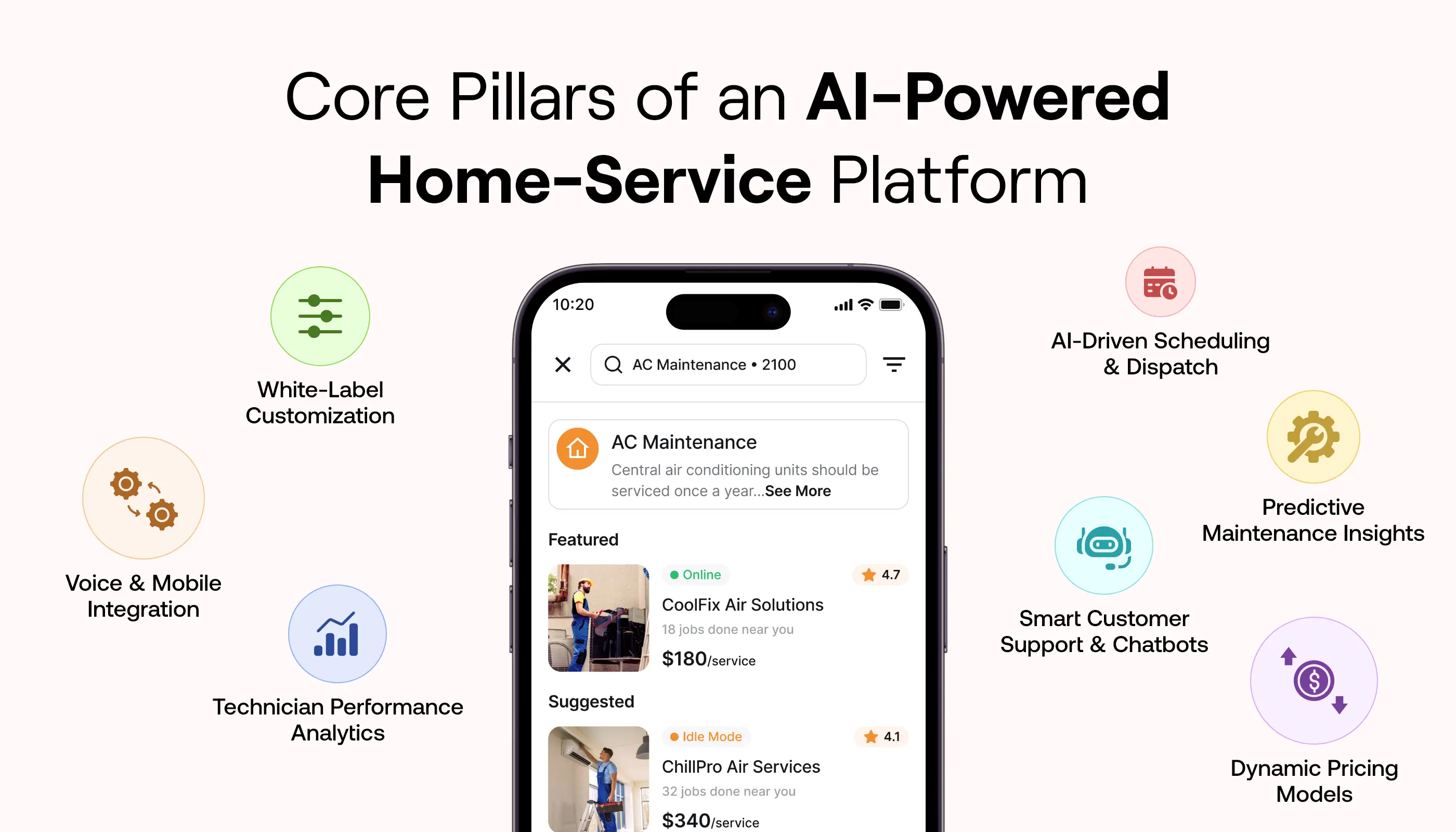
1. AI-Driven Scheduling & Dispatch
One of the most powerful features of an AI-powered platform is automated scheduling and dispatch. Instead of relying on manual coordination, AI assigns jobs to technicians based on skill level, location proximity, and real-time availability.
The system evaluates multiple parameters – such as estimated travel time, workload balance, and service priority – to ensure faster response and minimal idle time.
For example, an HVAC company can automatically route technicians to nearby repair jobs, cutting travel time and fuel costs while improving same-day service capacity.
2. Predictive Maintenance Insights
AI can predict when a customer’s equipment might fail, allowing service companies to take action before problems arise. By analyzing usage patterns, historical maintenance data, and IoT sensor readings, the platform identifies early warning signs of breakdowns. This not only improves equipment lifespan but also builds customer trust by preventing costly emergencies.
Plumbing or HVAC businesses using AI-based service management software can turn maintenance into a proactive service instead of a reactive one—boosting customer satisfaction and reducing unplanned downtime.
3. Smart Customer Support & Chatbots
Customers today expect instant responses. AI chatbots integrated into web or mobile apps can handle bookings, respond to FAQs, and guide users through troubleshooting steps 24/7. These chatbots use natural language processing (NLP) to understand and answer questions just like a human representative.
For instance, when a customer messages, “My AC isn’t cooling,” the bot can ask for details, suggest possible causes, and even schedule a technician visit—no human involvement required.
4. Dynamic Pricing Models
AI helps service providers stay competitive by automatically adjusting pricing based on demand, location, time, and resource availability. During peak seasons like summer for HVAC or monsoon for plumbing, the system can optimize pricing while maintaining fairness.
This ensures higher revenue during high-demand periods and improved booking rates during slow seasons. Companies that use AI-driven pricing tools experience better profit margins and predictable earnings without constant manual adjustments.
5. Technician Performance Analytics
Tracking technician performance manually can be inconsistent and time-consuming. An AI-powered dashboard simplifies this by gathering real-time data from completed jobs, customer feedback, and service times.
Managers can view insights such as completion rates, first-time fix ratios, and customer ratings to identify top performers or areas that need improvement. Over time, this helps improve service quality, boost productivity, and streamline workforce planning.
6. Voice & Mobile Integration
Technicians often work hands-on, making manual data entry difficult. AI voice assistants and mobile apps allow them to manage tasks, update job status, and navigate routes using voice commands or simple taps.
This mobile-first platform for service businesses helps technicians stay connected in the field while maintaining accurate records. Real-time updates also ensure that customers receive instant notifications when their technician is en route or the job is completed.
7. White-Label Customization
For enterprises and franchise owners, white-label flexibility is crucial. It allows businesses to rebrand the software with their logo, colors, and domain—offering a professional and unified customer experience.
White-label home-service software also supports multi-business ownership, enabling companies to manage multiple locations or brands from a single dashboard. This reduces dependency on third-party tools and keeps all operations within one ecosystem.
The Evolution of Home-Service Businesses
For decades, home-service businesses like HVAC, plumbing, and electrical repairs operated through manual systems. Customers would call service providers, book appointments over the phone, and wait for technicians without real-time updates.
Business owners relied on notebooks, spreadsheets, or paper invoices to track payments and job progress. It was a process that worked—but only until customer expectations changed and competition increased.
In traditional setups, the workflow was highly dependent on human coordination. A single miscommunication could result in double bookings, lost customer details, or unassigned jobs. Many companies had no structured system for tracking technician availability, work quality, or time spent on each task.
Payments often involved manual cash collection or delayed billing, leaving room for accounting errors. As the customer base grew, it became harder to maintain consistency, speed, and transparency—all essential for building trust in a service-driven business.
These manual systems led to several operational pain points:
- Missed appointments due to unorganized scheduling.
- Inconsistent customer communication, especially during delays or rescheduling.
- Untracked technician productivity, making it difficult to assess performance or identify inefficiencies.
- Lack of data insights, which prevented business owners from making informed decisions about resources or revenue trends.
To stay competitive, businesses began turning to digital tools and field service management software. The first wave of digital transformation introduced online booking forms, CRM systems, and basic scheduling apps.
These solutions allowed customers to book services anytime and receive confirmation via email or text. Companies gained visibility into their workforce, could assign jobs more efficiently, and started tracking key metrics like response time and job completion rate.
For many HVAC and plumbing companies, this shift reduced administrative work and improved overall service quality.
However, digital adoption was just the beginning. As customer expectations evolved toward instant communication and predictive service, simple automation wasn’t enough.
Businesses needed systems that could make intelligent decisions, learn from data, and adapt to real-time conditions. This is where AI-powered home-service platforms emerged as the next stage of evolution.
AI brought the ability to automate complex tasks—like assigning technicians based on skill and proximity, predicting equipment failures, or analyzing customer feedback for service improvements. It helped home-service providers go beyond basic digitization to achieve full business intelligence and automation.
Today, forward-thinking companies are embracing AI-driven platforms to deliver faster, smarter, and more personalized service experiences—setting a new standard for efficiency and customer satisfaction in the home-service industry.
Market Snapshot: Global On-Demand Home Services
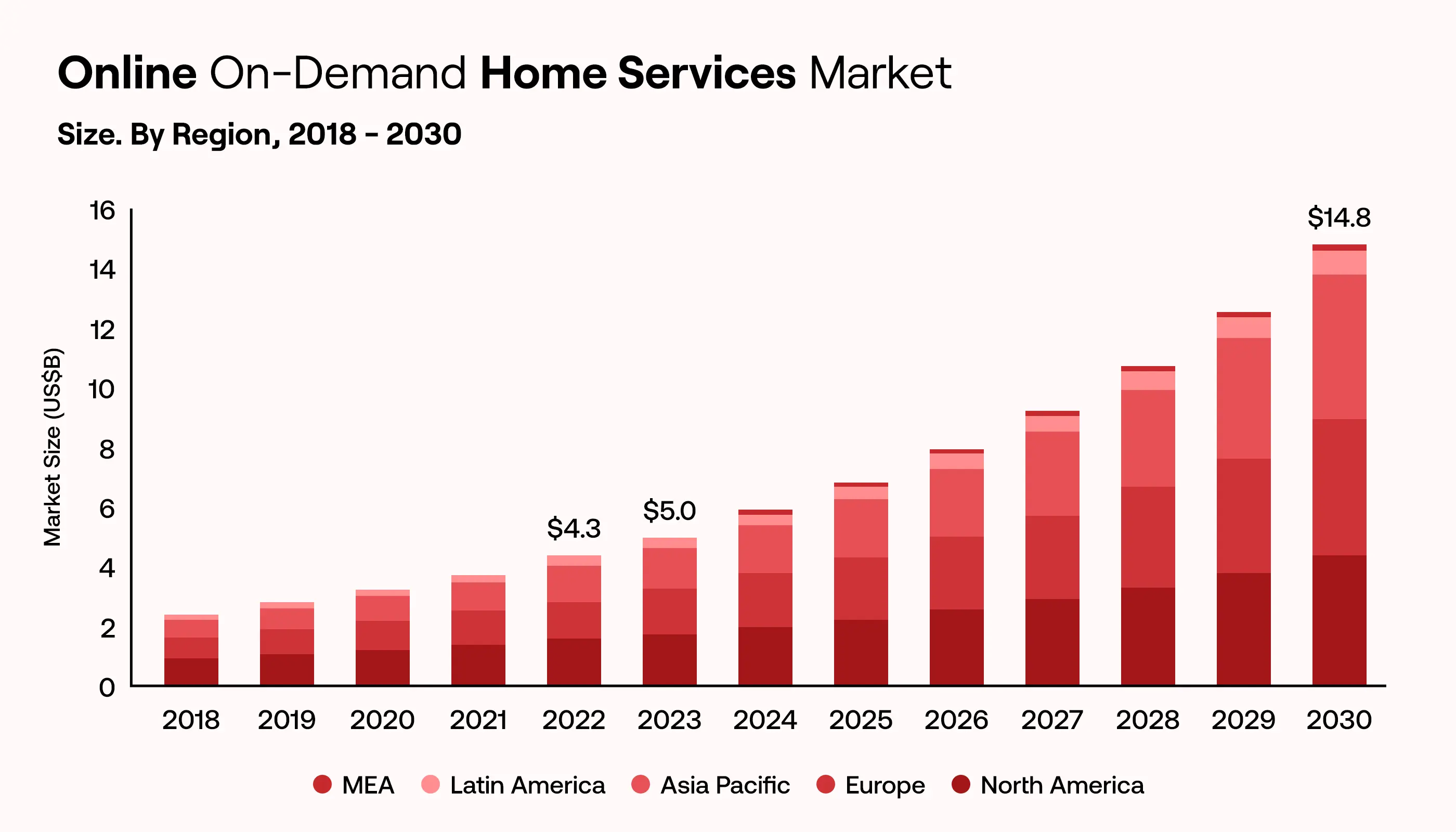
| Metrics | Details |
| 2021 Market Size | USD 3.71 Billion |
| 2030 Projected Market Size | USD 14.7 Billion |
| CAGR (2022–2030) | 16.7% |
| North America | Largest market (35% share in 2021) |
| Asia Pacific | Fastest growing region (CAGR 19.2%) |
| By Platform | Mobile dominated with 72% market share (2021) |
| By Type | Home cleaning led with 40% market share (2021) |
The rapid rise of mobile-first platforms and AI-driven automation reflects a clear shift toward convenience, transparency, and digital control in home-service delivery. Businesses that embrace these technologies early stand to capture a larger share of this fast-growing, multi-billion-dollar market.
Why AI Is a Game-Changer for Home-Service Providers
Artificial Intelligence is changing how home-service businesses operate. From HVAC and plumbing to electrical and cleaning services, AI helps companies move away from manual operations and toward intelligent, automated systems that run efficiently and predictably.
With the help of AI solutions for home-service providers, companies can now manage everything – from bookings and technician tracking to predictive maintenance and customer insights – on one unified platform.
AI brings automation, accuracy, and foresight to everyday tasks that used to rely on guesswork or human scheduling. Let’s explore how it transforms key areas of the service business.
1. Predictive Maintenance
AI-driven platforms analyze equipment usage patterns, weather data, and service history to forecast potential breakdowns before they happen.
For example, an HVAC company can use predictive analytics to detect when an air conditioning unit is likely to fail based on compressor vibration and temperature patterns.
Instead of waiting for a customer complaint, the system automatically alerts the technician to schedule preventive maintenance – minimizing downtime and boosting trust.
2. Intelligent Scheduling and Dispatch
In traditional operations, scheduling technicians is often manual and prone to delays. Field service management with AI solves this problem by analyzing technician skill sets, availability, job proximity, and traffic conditions to assign the right person for each task.
If a technician finishes early or a new emergency request comes in, AI dynamically adjusts routes and reassigns jobs – making sure every minute is used efficiently.
3. AI for Service Booking and Technician Tracking
Smart booking assistants powered by AI chatbots simplify customer interactions. A user can book plumbing or repair services instantly via chat or voice commands.
Once a job is scheduled, AI tracks technician movement through GPS and provides customers with real-time status updates, estimated arrival times, and service confirmations. This improves transparency, reduces no-shows, and enhances customer satisfaction.
4. Data-Driven Customer Analytics
AI platforms collect and analyze data from every service interaction – feedback scores, completion times, and repeat bookings. These insights help business owners identify trends, reward top-performing technicians, and optimize pricing strategies.
By understanding which services are in high demand or which customers are likely to churn, businesses can make faster, smarter decisions.
5. Real-World Impact
- HVAC companies are using AI to predict system failures, reduce service calls by 25%, and improve first-time fix rates.
- Plumbing services are leveraging AI-powered automation to assign urgent jobs instantly, cutting response times by up to 40%.
AI doesn’t just improve efficiency – it redefines how home-service companies operate. From scheduling to tracking, every touchpoint becomes intelligent, predictive, and customer-focused. In short, when you automate home-service operations with AI, you gain more time, more accuracy, and more loyal customers – all while reducing manual overhead and human error.
Business Benefits of Digitization
Digital transformation has become a game-changer for the home-service industry, especially for HVAC, plumbing, electrical, and cleaning companies.
Moving from manual, paper-based systems to AI-powered platforms helps service providers work faster, serve better, and scale smarter.
Let’s look at the main benefits of digitizing a home-service business and how it directly impacts bookings, customer satisfaction, and overall growth.

1. Improved Operational Efficiency
Digitization removes bottlenecks caused by manual scheduling, miscommunication, and repetitive admin tasks. An AI-powered home-service platform automates dispatching, assigns technicians based on proximity and skill, and tracks jobs in real time.
This leads to nearly 40% faster service dispatch and tracking, reducing idle time and boosting technician productivity.
Field managers can view all operations on a single dashboard, ensuring better coordination and quicker decision-making.
2. Enhanced Customer Experience
In today’s on-demand economy, customers expect convenience and instant updates. A digital transformation for HVAC and plumbing companies enables 24/7 service bookings, real-time notifications, and live technician tracking.
AI chatbots provide quick responses to FAQs, quotes, and appointment rescheduling, improving engagement and satisfaction. By giving customers full transparency – from request to completion – businesses build trust, loyalty, and repeat bookings.
3. Data-Driven Decision Making
When every interaction, job, and payment is recorded digitally, it creates a valuable data trail. AI-based service management software turns this data into insights – highlighting trends, peak service hours, technician performance, and customer feedback.
Managers can easily identify revenue leaks or underperforming areas and make informed decisions. Over time, these insights help optimize workforce allocation, pricing, and marketing strategies for maximum efficiency and profit.
4. Increased Bookings and Revenue
Automation directly contributes to business growth. With faster response times, proactive follow-ups, and improved service reliability, businesses often see a 30% increase in repeat customers and higher average job value. AI-driven marketing tools can recommend maintenance plans or seasonal offers based on customer history, leading to more cross-selling and upselling opportunities. This not only increases bookings but also ensures long-term customer retention.
5. Lower Costs and Higher ROI
Digitization minimizes errors that typically lead to financial loss – like missed appointments, incorrect invoices, or double bookings. Automated workflows cut administrative costs and reduce dependency on manual oversight.
As operations become more efficient, companies can serve more clients with the same workforce, improving return on investment.
Over time, the savings from automation easily outweigh the cost of implementing an AI-powered home-service platform.
6. Scalability and Growth Readiness
As businesses grow, managing multiple service zones or teams becomes complex. A mobile-first platform for service businesses makes scaling effortless by standardizing processes across regions.
AI automation handles higher service volumes without compromising on quality. Whether expanding to new cities or managing franchise operations, digitized systems maintain consistency, reliability, and brand reputation – helping businesses grow sustainably.
Digitization Isn’t the Future-It’s the Now
Start automating your home-service workflows with AI and watch efficiency, accuracy, and revenue grow together.
What’s the Difference Between a White-label and a Custom Home-service App?
In today’s home-service industry, choosing the right digital foundation can make or break your automation strategy. Businesses often face a critical decision: whether to build a custom AI-powered home-service app from scratch or adopt a white-label home-service software that’s ready to deploy. Both options offer unique advantages depending on your goals, budget, and growth stage.
Understanding Both Approaches
White-Label Home-Service Software
A white-label platform is a ready-made digital solution developed by a third party that you can brand as your own. It already includes essential modules like booking, dispatch, payment, and customer management, allowing you to launch quickly with your brand identity and domain. It’s ideal for companies that want to digitize fast without heavy investment in R&D.
Custom Home-Service App Development
A custom-built platform is created entirely from the ground up according to your specific business workflows, service categories, and user experience goals. It’s a long-term investment suited for established brands that require unique features, complex integrations, or a fully proprietary AI engine.
Quick Comparison Table
| Parameter | White-Label Platform | Custom Development |
| Development Time | 2–6 weeks (ready-to-launch) | 6–12 months (from scratch) |
| Initial Cost | Low setup fee or subscription | High upfront cost (design + dev) |
| Customization | Limited to UI/branding and minor modules | Fully customizable across all features |
| Scalability | Moderate – fits most SMB and mid-level needs | High – tailored to enterprise-grade expansion |
| AI Integration | Pre-built modules for chatbots, scheduling, analytics | Custom AI models trained on your data |
| Maintenance | Managed by vendor | Managed internally or outsourced |
| Ownership | Licensed use under your brand | Full ownership of code and data |
| Time to Market | Fast deployment | Slow but strategically planned |
| Ideal For | Startups, small providers, franchises | Enterprises, multi-region operators |
Recommendations by Business Type
- For Startups and Local Providers: A white-label home-service software is the smartest way to digitize quickly. It eliminates the complexity of development, keeps costs predictable, and allows you to focus on acquiring customers and improving operations rather than managing tech.
- For Franchises and Growing Businesses: Go for a hybrid approach — start with a white-label base to validate the digital model, then customize modules (like AI-based scheduling or customer analytics) as your needs grow.
- For Enterprise-Level Providers: A custom-built, AI-powered home-service platform provides the flexibility, security, and scalability large organizations demand. You can integrate proprietary AI algorithms, link ERP and CRM systems, and maintain complete control over data, compliance, and innovation.
Therefore, your choice depends on your time-to-market goals, budget, and scalability needs. Startups thrive with ready-to-launch white-label solutions, while enterprises benefit from investing in long-term, custom-built, mobile-first platforms for service businesses that align with their brand vision and AI roadmap.
Top AI Tools and Technologies Powering Home-Service Digitization
Artificial Intelligence has become the driving force behind modern AI-based service management software. For home-service providers, choosing the right tools and technologies is crucial for ensuring efficiency, scalability, and customer satisfaction. Here’s a straightforward overview of the most widely used tools, frameworks, and integrations that power today’s AI-powered home-service platforms.
AI and Machine Learning Frameworks
- Google Cloud AI – Offers powerful APIs for image recognition, natural language understanding, and predictive analytics to automate scheduling and maintenance insights.
- AWS AI Services – Provides end-to-end solutions for chatbots, forecasting, and sentiment analysis to help automate operations and improve customer interactions.
- OpenAI – Powers conversational AI, intelligent recommendations, and automated communication through models like GPT for smarter customer engagement.
- Dialogflow – Ideal for building voice and text-based chatbots, enabling seamless booking and inquiry management in home-service scheduling and dispatch apps.
- TensorFlow – Used for training and deploying machine learning models that support predictive maintenance, pricing optimization, and customer analytics.
- Whisper API – Enables accurate voice-to-text transcription for voice assistants, allowing service technicians to log work orders or updates hands-free.
- spaCy – Supports natural language processing (NLP) for analyzing customer messages and extracting service requests automatically.
Mobile and Backend Tech Stack
Modern AI solutions for home-service providers rely on strong mobile-first architecture for smooth user experiences.
- Flutter and React Native are leading frameworks for building high-performance, cross-platform mobile apps for customers and technicians.
- JS and Python power backend logic, AI integration, and real-time data communication between field technicians and admin dashboards.
- MySQL ensures secure, structured storage of booking data, service history, and customer feedback—supporting scalability as the business grows.
Essential Integrations
A complete digital ecosystem connects multiple services and automations:
- GPS Tracking – Enables real-time technician monitoring, optimized routes, and location-based job assignments.
- Payment Gateways such as Stripe and Razorpay ensure quick, secure, and multi-currency payments within the mobile app.
- SMS and Email Automation tools send instant alerts, booking confirmations, and review requests to customers.
Together, these technologies create a unified, intelligent environment that helps businesses automate home-service operations, reduce manual effort, and deliver exceptional customer experiences. By adopting this integrated stack, service providers can future-proof their operations and achieve higher efficiency through intelligent automation.
Measuring ROI of AI-Powered Transformation
Measuring the return on investment (ROI) from an AI-powered home-service platform goes beyond just profits – it reflects time savings, productivity improvements, and happier customers. The goal is to track how automation and data-driven insights translate into real business outcomes that impact daily operations.
- Time Saved per Booking: AI streamlines scheduling, dispatch, and follow-up communication. What once took several minutes of manual coordination now happens in seconds. For instance, businesses often record up to 35% faster job allocation, meaning technicians spend more time on-site rather than waiting for assignments. Faster response times not only increase customer satisfaction but also allow teams to handle more bookings per day.
- Technician Productivity Increase: By automating task assignment and route planning, technicians can complete more jobs in less time. Field visibility and performance tracking tools help managers identify top performers and optimize underperforming routes. Many businesses experience around a 40% drop in administrative time and a 20–25% increase in overall productivity after integrating AI into their workflows.
- Customer Satisfaction Scores (NPS): AI-powered chatbots and predictive service reminders enhance customer engagement. Automated updates, accurate ETAs, and feedback loops directly improve Net Promoter Scores (NPS). Higher NPS reflects stronger customer trust, which contributes to repeat bookings and positive referrals.
- Revenue Growth and Repeat Jobs: Digital platforms capture valuable customer behavior data—what services are requested most, when demand peaks, and which technicians perform best. Using these insights, businesses can design targeted offers or loyalty programs that drive 25% higher conversion rates and steady revenue growth over time.
Ultimately, ROI isn’t only financial. It’s also about creating a smoother, more predictable operation. When AI reduces manual errors, enhances transparency, and keeps customers informed, businesses gain consistency and confidence in their service delivery. This combination of efficiency, accuracy, and customer satisfaction forms the true measure of success in an AI-powered transformation.
Case Study: How HomesOps Digitized Its Service Operations with AI

Before digitization, HomesOps, a mid-sized HVAC and plumbing service provider, faced several challenges in daily operations. Customer bookings were handled manually, technicians relied on phone updates, and billing was paper-based. These inefficiencies led to delays, missed appointments, and poor customer experience.
Challenges Before Digitization
- Manual booking system resulted in double bookings and missed appointments.
- Technicians received jobs via calls, causing confusion and overlap.
- Paper-based invoices made tracking payments slow and error-prone.
- No real-time visibility into technician locations or job progress.
- Limited data insights to evaluate performance or plan preventive maintenance.
To address these issues, the management decided to implement an AI-powered home-service platform that could automate, organize, and optimize their entire workflow.
AI-Driven Transformation
The new platform unified all service operations through automation and predictive intelligence.
- AI Scheduling & Dispatch: Automatically assigned the best technician based on proximity, skill, and availability—cutting coordination time by 60%.
- AI Chatbot Assistance: Enabled 24/7 customer interaction for bookings, FAQs, and rescheduling through both web and mobile apps.
- Technician Tracking System: Provided real-time visibility of job status, route progress, and service completion.
- Smart Analytics Dashboard: Tracked performance metrics like response time, completion rate, and feedback scores.
- Predictive Maintenance: AI analyzed service history to suggest preventive visits, increasing repeat business.
Results Achieved
Within six months of adopting the AI-powered home-service platform, HomesOps achieved measurable improvements across multiple KPIs:
- 40% increase in service bookings through faster response times and instant scheduling.
- 30% reduction in missed or delayed jobs, improving on-time service delivery.
- 85% customer satisfaction rate driven by transparent communication and automated updates.
- Simplified technician workflows with digital job cards, image uploads, and instant payment options.
- Enhanced operational visibility for managers with live dashboards and data-driven decision-making.
Outcome
HomesOps successfully transformed from a manual, fragmented setup into a fully digitized and automated business. By leveraging AI scheduling, chatbot automation, and predictive analytics, it built a scalable, mobile-first platform that improved both efficiency and customer loyalty.
Conclusion
AI is transforming how home-service businesses operate, making every process faster, smarter, and more efficient. From automated scheduling to real-time technician tracking, AI-powered platforms from Codiant elevate traditional workflows into intelligent, self-optimizing systems that boost customer satisfaction.
By digitizing operations, HVAC, plumbing, and electrical companies can reduce manual work, improve accuracy, and scale effortlessly. The future of service management is mobile, data-driven, and AI-enabled—empowering businesses to grow sustainably with innovation at every step.
Your Next Booking Could Be Fully Automated
Want to see how AI can cut manual work, boost bookings, and modernize your service operations effortlessly?
Frequently Asked Questions
Digitizing a home-service business means shifting your operations—like bookings, invoicing, scheduling, and customer communication—from manual or paper-based systems to digital tools and platforms. It helps automate routine tasks, track technicians in real time, and improve the overall customer experience.
AI automates scheduling by assigning technicians based on availability, location, and job type. It generates instant invoices after job completion and updates service status in real time. This reduces manual errors and ensures faster turnaround for both providers and customers.
Costs depend on the platform type, features, and scale. White-label solutions may start at a few hundred dollars per month, while custom-built AI platforms can cost anywhere between $10,000 and $50,000 based on integrations and advanced analytics.
Yes. Small service providers can use affordable AI-powered tools to automate bookings, manage customers, and monitor technicians. Many platforms offer pay-as-you-go or subscription models that make AI integration cost-effective and scalable.
ROI can be measured through time saved on manual tasks, faster response times, higher booking rates, reduced operational costs, and improved customer satisfaction. Tracking KPIs like job completion time and repeat bookings can show clear business impact.
Start by identifying repetitive tasks such as scheduling or follow-ups. Then, choose an AI-powered home-service platform that automates these workflows. Integrate it with your CRM, train your team, and use analytics to monitor performance improvements.
AI helps HVAC and plumbing companies predict maintenance needs, optimize technician routes, automate customer communication, and generate real-time service reports. This leads to fewer missed appointments, higher efficiency, and better customer retention.
AI automatically matches service requests to the nearest and most qualified technician. It adjusts schedules dynamically based on job urgency and technician availability, ensuring faster response times and more efficient dispatching.
Look for features like AI-driven scheduling, customer portals, technician tracking, integrated payments, chatbots, real-time analytics, review management, and white-label customization. These capabilities improve productivity and simplify daily operations.
Digitization enables 24/7 online booking, instant confirmations, transparent pricing, and real-time updates. Customers enjoy a smoother experience, while providers gain more leads, repeat customers, and better service ratings.
Top tools include Housecall Pro, Jobber, ServiceTitan, and Zoho FSM, each offering AI-based scheduling, dispatching, and customer management. Many also support route optimization and mobile app integration for on-field teams.
Apps like HomesOps, Workiz, FieldAware, and ServiceM8 provide AI-powered real-time job dispatching. They help assign tasks instantly, track technicians, and update customers about arrival times and job status.
Featured Blogs
Read our thoughts and insights on the latest tech and business trends
How a Voice AI Agent Can Help You Get More Appointments and Leads
- November 17, 2025
- Artificial Intelligence
Missed calls, delayed responses, and lost leads are silent revenue killers for many businesses. In today’s fast-moving market, customers expect instant engagement - and that’s exactly where a voice AI agent for appointment booking steps... Read more
How to Integrate AI in Recruitment and Cut Hiring Time by 70%
- November 13, 2025
- Artificial Intelligence
Recruiting teams face a clear operational challenge: too much manual work and not enough qualified talent reaching the finish line. Even with modern ATS systems, most hiring workflows still depend on human-driven screening, coordination, and... Read more
How to Build AI Agents That Can Speed Up Your Work and Reduce Other Expenses
- November 10, 2025
- Artificial Intelligence
Businesses today are looking for faster ways to work and smarter tools that cut costs. That’s why AI agents are quickly becoming a key investment for companies of all sizes. These autonomous systems can perform... Read more



